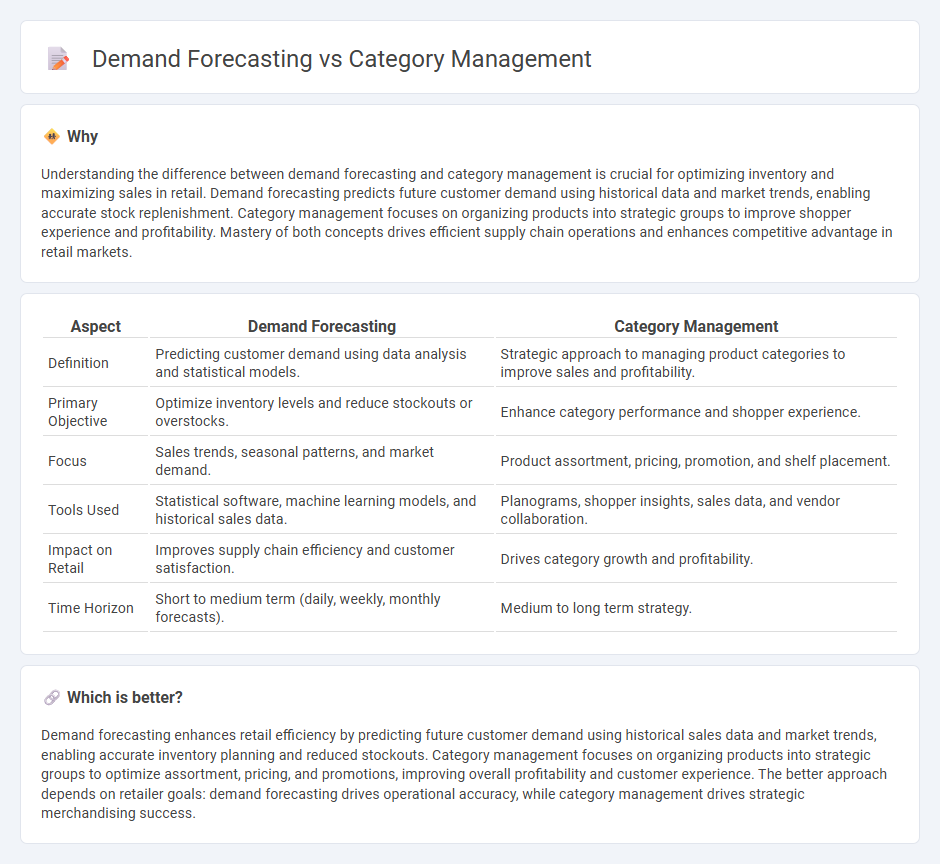
Demand forecasting uses historical sales data and market trends to predict future consumer demand, enabling retailers to optimize inventory levels and reduce stockouts or overstock situations. Category management focuses on grouping related products to maximize sales and profitability through tailored merchandising, pricing, and promotion strategies. Discover how integrating demand forecasting with category management can drive smarter retail decisions and boost overall performance.
Why it is important
Understanding the difference between demand forecasting and category management is crucial for optimizing inventory and maximizing sales in retail. Demand forecasting predicts future customer demand using historical data and market trends, enabling accurate stock replenishment. Category management focuses on organizing products into strategic groups to improve shopper experience and profitability. Mastery of both concepts drives efficient supply chain operations and enhances competitive advantage in retail markets.
Comparison Table
| Aspect | Demand Forecasting | Category Management |
|---|---|---|
| Definition | Predicting customer demand using data analysis and statistical models. | Strategic approach to managing product categories to improve sales and profitability. |
| Primary Objective | Optimize inventory levels and reduce stockouts or overstocks. | Enhance category performance and shopper experience. |
| Focus | Sales trends, seasonal patterns, and market demand. | Product assortment, pricing, promotion, and shelf placement. |
| Tools Used | Statistical software, machine learning models, and historical sales data. | Planograms, shopper insights, sales data, and vendor collaboration. |
| Impact on Retail | Improves supply chain efficiency and customer satisfaction. | Drives category growth and profitability. |
| Time Horizon | Short to medium term (daily, weekly, monthly forecasts). | Medium to long term strategy. |
Which is better?
Demand forecasting enhances retail efficiency by predicting future customer demand using historical sales data and market trends, enabling accurate inventory planning and reduced stockouts. Category management focuses on organizing products into strategic groups to optimize assortment, pricing, and promotions, improving overall profitability and customer experience. The better approach depends on retailer goals: demand forecasting drives operational accuracy, while category management drives strategic merchandising success.
Connection
Demand forecasting leverages historical sales data and market analysis to predict future product demand, enabling retailers to optimize inventory levels. Category management uses these demand insights to organize product assortments and plan promotions that align with consumer buying patterns. This synergy enhances sales performance and reduces stockouts or overstock situations in retail operations.
Key Terms
Category management:
Category management optimizes the assortment, pricing, and promotion of product categories to maximize sales and profitability by aligning inventory with consumer preferences and market trends. It relies heavily on data analytics and shopper insights to tailor strategies that enhance product visibility and customer satisfaction. Explore how advanced category management techniques drive retail growth and operational efficiency.
Assortment Planning
Category management enhances assortment planning by analyzing consumer behavior, sales trends, and competitive landscape to optimize product mix and shelf space allocation. Demand forecasting supports assortment planning through predicting future sales volumes using historical data and market indicators, helping prevent stockouts and overstock situations. Explore how integrating category management with demand forecasting can maximize inventory efficiency and improve customer satisfaction.
Planogram
Category management maximizes retail efficiency by organizing products strategically, while demand forecasting predicts customer purchasing behavior using historical data and analytics to optimize inventory. Effective planogram design leverages insights from both category management and demand forecasting to enhance shelf space allocation, improve product visibility, and drive sales. Explore how integrating these approaches can transform retail merchandising strategies.
Source and External Links
Category management - Wikipedia - Category management is a retail and procurement strategy that organizes products into discrete groups for management as strategic business units, fostering collaboration between retailers and suppliers to optimize the whole category's performance rather than individual products.
What is Category Management in 2024? - Procurify - Category management is a strategic procurement approach emphasizing cross-functional collaboration, continuous improvement, and technology adoption to optimize product assortments and supplier relationships, thereby driving business growth and efficiency.
Category Management: Definition, Examples and Benefits - Tipalti - Category management systematically groups procurement spend to reduce costs and improve supplier collaboration over the long term, distinguishing itself from strategic sourcing by focusing on ongoing market analysis and holistic management across the company.
 dowidth.com
dowidth.com